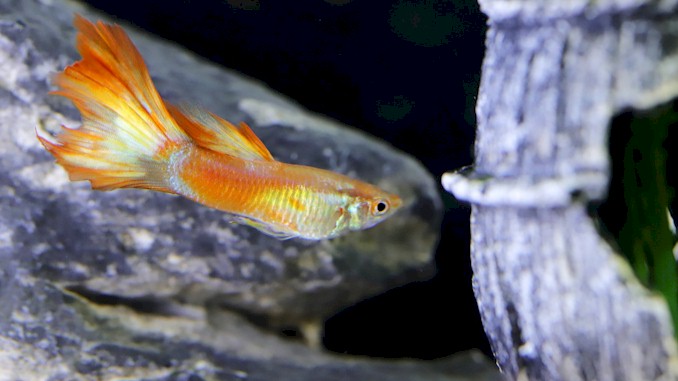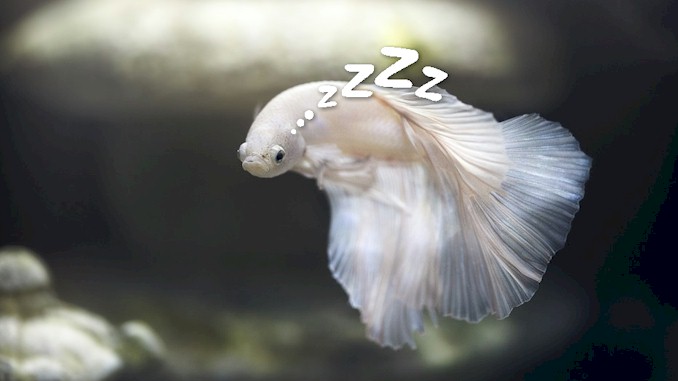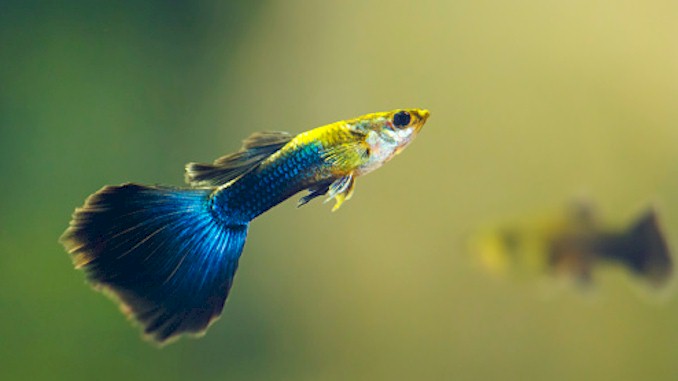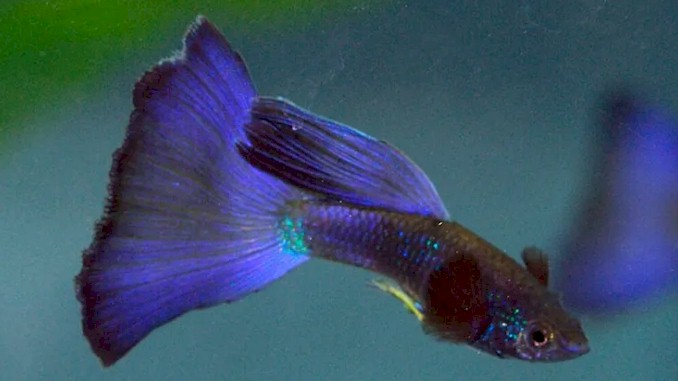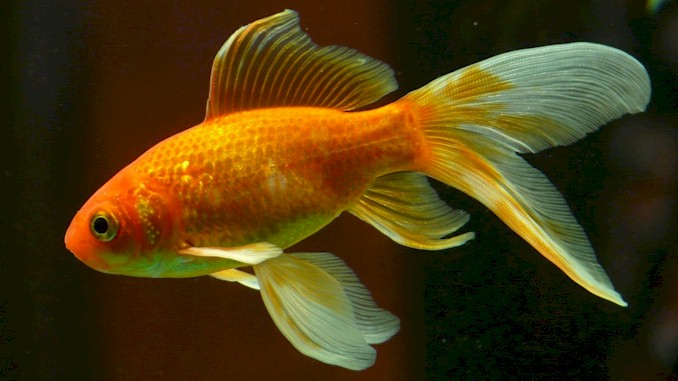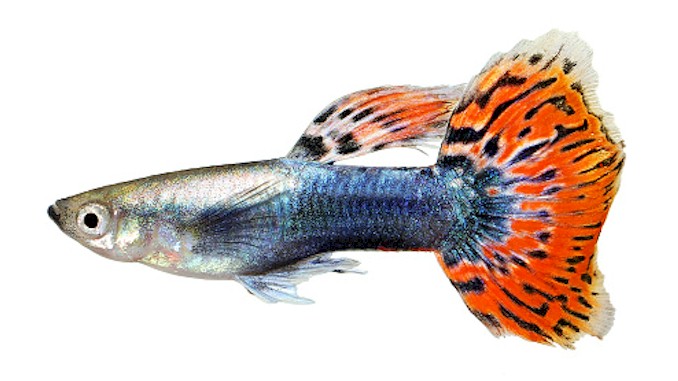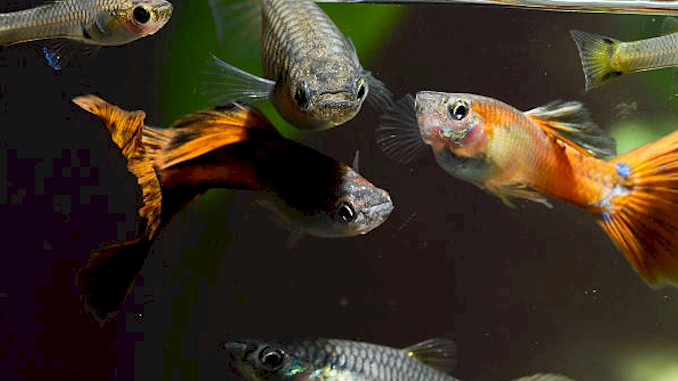The Ultimate Guide to Guppy Growth Stages (With Pictures)
As someone who has studied guppies extensively, I can confidently say that understanding their growth stages is crucial for any guppy owner or breeder. I have witnessed the various phases of guppy development and have gained valuable insights into their growth patterns. In this blog post, I will be sharing my knowledge on the different growth stages of guppies, including the factors that influence their growth and how to properly care for them during each phase. By the end of this article, you will have a comprehensive understanding of guppy growth stages that will help you raise healthy and thriving guppies.
Guppy growth stages are divided into four main phases: fry, juvenile, subadult and adult. Each stage is characterized by distinct physical changes and behavioral patterns, and factors such as temperature, water quality, and diet can influence their growth.
You may have noticed that guppies go through different growth stages, from fry to adult. But do you know what happens in each phase? How long does it take for a guppy to reach maturity? What are the signs of healthy growth and development? And how can you provide the best care for your guppies at every stage? Read on and you will find all answers here:
What is the fry stage and how to care for guppy fry?
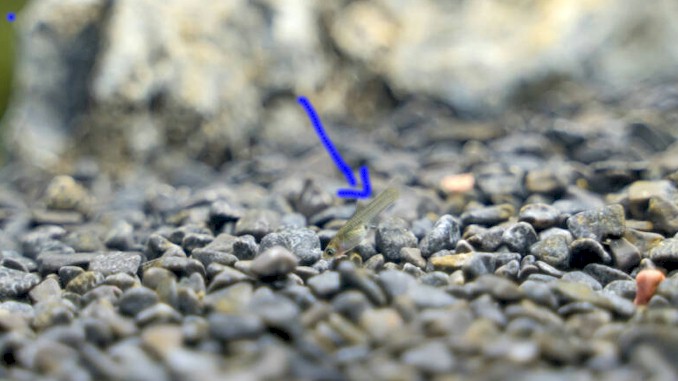
The fry stage is the first phase of guppy growth, starting from birth until about four weeks of age. During this stage, guppy fry are very small (about 6 mm long) and vulnerable to predators, including their own parents. Therefore, proper care for guppy fry is essential to ensure their survival and development.
One of the most important aspects of caring for guppy fry is providing them with a safe and suitable tank environment. There are two main options for setting up a tank for guppy fry: using a separate breeding tank or using a breeding box within the main tank.
A separate breeding tank is a dedicated aquarium where you can transfer pregnant female guppies before they give birth. This way, you can isolate the fry from any potential threats and monitor their progress more easily. A 10-gallon tank is a good size for a small number of fry, but you may need a larger tank if you plan to breed multiple batches of fry.
A breeding box is a small mesh or plastic container that you can insert into your main tank. It allows water to flow through but prevents adult fish from entering or leaving. You can place pregnant female guppies inside the breeding box until they deliver their babies. Then, you can remove the mother and leave the fry inside the box until they are big enough to join the rest of the tank.
Whichever option you choose, make sure to maintain optimal water conditions for your guppy fry. The water temperature should be between 78-82°F (26-28°C), as warmer water speeds up their metabolism and growth. You should also perform regular water changes (20-30% once a week) and use a water conditioner to remove any chlorine or chloramine from tap water. Additionally, you should test your water parameters regularly and keep them within these ranges:
- pH: 6.8-7.8
- Ammonia: 0 ppm
- Nitrite: 0 ppm
- Nitrate: <20 ppm
Another key aspect of caring for guppy fry is providing them with adequate hiding places. Guppy fry are very timid and need places where they can feel safe and secure. You can use live or artificial plants, rocks, driftwood, caves, or other decorations to create sheltered areas in your tank. Some examples of plants that are suitable for guppy tanks are:
- Guppy grass (Najas guadalupensis)
- Hornwort (Ceratophyllum demersum)
- Java moss (Vesicularia dubyana)
- Water lettuce (Pistia stratiotes)
These plants not only offer cover for your fry but also oxygenate the water, absorb excess nutrients, and provide natural food sources.
The final aspect of caring for guppy fry is feeding them properly. Guppy fry have very small mouths but very big appetites. They need high-quality, protein-rich foods that can support their rapid growth and development. You should feed your fry at least three times a day in small amounts that they can consume within a few minutes. You can also feed them more frequently (5-10 times a day) if you want them to grow faster.
Some examples of foods that are suitable for guppy fry are:
- Baby brine shrimp
- Micro worms
- Vinegar eels
- Infusoria
- Crushed flakes or pellets
What is the juvenile stage and how to identify guppy gender?
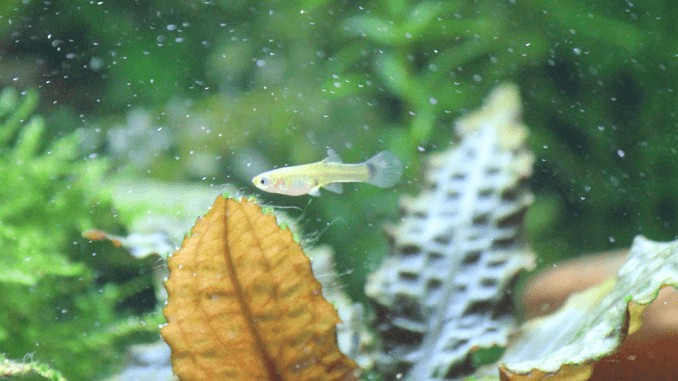
The juvenile stage is the second phase of guppy growth, lasting from about four weeks to two months of age. During this stage, guppy fry start developing their adult features, such as coloration, fin shape, and sexual organs. Juvenile guppies also become more active and curious, exploring their tank and interacting with other fish.
One of the most noticeable changes that occur in juvenile guppies is the differentiation of their gender. Male and female guppies have distinct physical characteristics that make them easy to tell apart once they reach adolescence. Here are some of the main differences between male and female guppies:
- Body size and shape: Female guppies are usually larger and rounder than male guppies, sometimes twice as big as males. Male guppies have slender and elongated bodies that allow them to swim faster and chase females.
- Coloration and patterns: Male guppies are usually more colorful and vibrant than female guppies, displaying a variety of hues and markings on their bodies and tails. They use their bright colors to attract females and compete with other males. Female guppies tend to have duller colors, such as gray or silver, with less or no patterns on their tails.
- Dorsal fin: The dorsal fin is the fin on top of the fish’s body. Male guppies have longer and more pointed dorsal fins that trail behind them in the water. Female guppies have shorter and more rounded dorsal fins that match their body shape.
- Anal fin: The anal fin is the fin below the fish’s tail. Male guppies have a modified anal fin called a gonopodium that serves as a reproductive organ. The gonopodium is long and narrow, resembling a rod or a hook. Female guppies have a normal anal fin that is triangular in shape.
- Gravid spot: The gravid spot is a dark patch near the anus of female livebearers that indicates pregnancy. It contains developing embryos that can be seen through the translucent skin of female guppies. The gravid spot becomes larger and darker as the pregnancy progresses. Male guppies do not have a gravid spot.
To identify the gender of your juvenile guppies, you can use these characteristics as a guide. However, keep in mind that some types of guppies may have variations or exceptions to these general rules. For example, some females may have more color than usual or some males may have shorter fins than others. Therefore, it’s best to look at multiple features rather than relying on one alone.
The table below summarizes some of the main differences between male and female juvenile guppies:
| Feature | Male Guppy | Female Guppy |
|---|---|---|
| Body size | Smaller | Larger |
| Body shape | Slender | Round |
| Coloration | Brighter | Duller |
| Patterns | More | Less |
| Dorsal fin | Longer/pointed | Shorter/rounded |
| Anal fin (gonopodium) | Long/narrow (rod/hook) | Triangular (normal) |
| Gravid spot | None | Present |
Identifying your juvenile guppy’s gender can help you plan ahead for breeding or separating them according to your preference. It can also help you appreciate their unique beauty and personality traits. Juvenile guppies are fun to watch as they grow into adulthood.
What is the subadult stage and how to prepare for guppy breeding?

The subadult stage is the third phase of guppy growth, lasting from about two months to four months of age. During this stage, guppy juveniles reach sexual maturity and become capable of reproducing. Subadult guppies also develop their full coloration and fin shape, making them more attractive to potential mates.
If you are interested in breeding your guppies, you will need to prepare for this stage by setting up a suitable breeding tank and selecting the fish you want to breed. Breeding guppies can be a rewarding and enjoyable experience, but it also requires some planning and care. Here are some steps you can follow to breed your guppies successfully:
- Set up a breeding tank: You will need a separate tank where you can place your chosen male and female guppies for breeding. The tank should be at least 10 gallons in size, with a heater, a gentle filter, and plenty of plants or decorations for hiding places. The water temperature should be between 77-80°F (25-27°C) while the fish are in the tank together . You should also perform regular water changes (20-30% once a week) and test your water parameters (pH, ammonia, nitrite, nitrate) frequently.
- Select the fish you want to breed: You should choose healthy and active guppies that have the characteristics you want to pass on to their offspring. These can include coloration, patterns, fin shape, body size, etc. You can use different breeds of guppies or create your own strains by selective breeding. Generally, you will want to select one male guppy for every two or three female guppies for breeding. This will reduce aggression and stress among the fish.
- Place the fish in the breeding tank: Once you have selected your fish, you can transfer them to the breeding tank. You should feed them high-quality foods that are rich in protein and vitamins before placing them in the tank. This will help them produce healthy eggs and sperm. You should also observe their behavior and look for signs of mating readiness. Male guppies will chase female guppies around the tank and display their colors and fins. Female guppies will show a dark gravid spot near their anus when they are pregnant.
- Remove the fish after mating: Guppies are livebearers, meaning they give birth to live young rather than laying eggs. The gestation period of female guppies is about 20-30 days. During this time, you should monitor your female guppies closely and look for signs of labor. These include swelling of the abdomen, restlessness, loss of appetite, hiding behavior, etc. Once you notice these signs or see any fry in the tank (baby guppies), you should remove both male and female adult guppies from the breeding tank as soon as possible. This is because adult guppies may eat their own fry or stress them out .
- Care for the fry: Guppy fry are very small (about 6 mm long) but very hungry when they are born. They need a safe and clean environment where they can grow and develop without being eaten or harmed by other fish. You should provide them with plenty of hiding places using plants or decorations. You should also feed them several times a day with small amounts of high-quality foods that are suitable for their size. Some examples of foods that are good for fry are baby brine shrimp (BBS), micro worms (MW), vinegar eels (VE), infusoria (IF), crushed flakes or pellets (CFP). You can also use commercial fry foods that are specially formulated for baby fish.
Breeding your own guppies can be an exciting hobby that allows you to create beautiful strains with unique traits. However, it also comes with some challenges and responsibilities that require your attention and care. By following these steps above ,you can prepare yourself for breeding your subadult guppies successfully.
What is the adult stage and how to maintain guppy health and color?

The adult stage is the final phase of guppy growth, lasting from about four months onwards. During this stage, guppies have reached their full size and coloration and can reproduce regularly. Adult guppies are beautiful and lively fish that can brighten up any aquarium with their vibrant hues and patterns.
However, adult guppies also face some challenges and risks that can affect their health and color. They may suffer from diseases, parasites, stress, aggression, or poor water quality. Therefore, it is important to provide them with optimal care and conditions that can keep them healthy and happy. Here are some tips on how to maintain your adult guppies’ health and color:
- Feed them a balanced diet: Guppies are omnivorous fish that need a variety of foods to meet their nutritional needs. You should feed them high-quality flakes or pellets that are specially formulated for guppies or tropical fish. You should also supplement their diet with live or frozen foods such as brine shrimp (BS), bloodworms (BW), daphnia (DP), tubifex worms (TW), etc. These foods provide protein, vitamins, minerals, and carotenoids that enhance your guppies’ coloration. You should feed your adult guppies once or twice a day in small amounts that they can consume within a few minutes.
- Keep the water clean and clear: Guppies prefer clean water in which to swim and breed. You should perform regular water changes (20-30% once a week) using a gravel vacuum to remove any waste or debris from the substrate. You should also use a water conditioner to remove any chlorine or chloramine from tap water. Additionally, you should test your water parameters regularly using a test kit or strips and keep them within these ranges:
- pH: 6.8-7.8
- Ammonia: 0 ppm
- Nitrite: 0 ppm
- Nitrate: <20 ppm
- Provide adequate lighting: Guppies need light to display their colors properly. You should provide them with at least 8 hours of light per day using an aquarium light fixture or natural sunlight. However, you should also provide them with some periods of darkness to mimic their natural day-night cycle and allow them to rest. Too much light can cause algae growth in your tank which can reduce water quality and oxygen levels.
- Avoid stress factors: Guppies are sensitive fish that can get stressed easily by various factors such as overcrowding, overfeeding, temperature fluctuations, noise, vibrations, etc. Stress can weaken your guppies’ immune system and make them more susceptible to diseases or parasites . It can also cause them to lose their appetite ,color ,or even die . Therefore ,you should avoid any stress factors that can harm your guppies’ well-being .You should also observe your guppies’ behavior regularly for any signs of stress such as clamped fins ,rapid breathing ,hiding ,or darting .
- Treat any diseases or parasites promptly: Guppies are prone to some common diseases or parasites such as fin rot (FR), ich (ICH), velvet (VEL), dropsy (DRP), anchor worms (AW), etc. These conditions can cause various symptoms such as white spots, fuzzy patches, red streaks ,swollen abdomen, worm-like protrusions, etc. If you notice any of these signs on your guppies, you should act quickly and treat them accordingly. You can use medications such as malachite green (MG),formalin (FM), potassium permanganate (PP), antibiotics (AB), etc., to treat different diseases or parasites. You should always follow the instructions on the label carefully when using any medications. You should also quarantine any sick or new fish in a separate tank until they recover fully.
Maintaining your adult guppies’ health and color is not difficult if you follow these tips above. By providing them with proper care and conditions, you can enjoy watching your beautiful fish for many years.
How to avoid common problems and diseases in guppy growth stages?
Guppies are generally hard and easy to care for, but they can still suffer from some common problems and diseases that can affect their growth and well-being. These include white spots (ich), velvet (Oodinium), fin rot, protozoan (guppy disease), Columnaris, dropsy, gill flukes, Camallanus worms, hole-in-the-head, bent spine, tuberculosis, etc. These conditions can cause various symptoms, such as white dots, fuzzy patches, red streaks, swollen abdomen, worm-like protrusions, etc., on your guppies.
The best way to avoid these problems and diseases is to prevent them from occurring in the first place. Prevention is always better than cure when it comes to fish health. Here are some steps you can take to prevent guppy problems and diseases:
- Maintain good water quality: Regular water changes (20-30% once a week) and filtration can help keep the water clean and healthy for your fish. You should also use a water conditioner to remove any chlorine or chloramine from tap water. Additionally, you should test your water parameters regularly using a test kit or strips and keep them within these ranges:
- pH: 6.8-7.8
- Ammonia: 0 ppm
- Nitrite: 0 ppm
- Nitrate: <20 ppm
- Avoid overcrowding: Overcrowding can cause stress and aggression among your fish which can weaken their immune system and make them more prone to diseases. You should provide enough space for your fish to swim comfortably without bumping into each other or the tank walls. A general rule of thumb is to have one inch of fish per gallon of water.
- Quarantine new fish: New fish may carry diseases or parasites that could infect your existing fish if you add them directly to your main tank. You should quarantine new fish in a separate tank for at least two weeks before introducing them to your main tank. You should also observe them closely for any signs of illness or abnormality during this period.
- Feed a balanced diet: Guppies need a variety of foods to meet their nutritional needs. You should feed them high-quality flakes or pellets that are specially formulated for guppies or tropical fish. You should also supplement their diet with live or frozen foods such as brine shrimp (BS), bloodworms (BW), daphnia (DP), tubifex worms (TW), etc. These foods provide protein, vitamins, minerals, and carotenoids that enhance your guppies’ coloration. It will help if you feed your adult guppies once or twice a day in small amounts that they can consume within a few minutes. You should feed your fry several times a day with small amounts of suitable foods.
- Provide adequate lighting: Guppies need light to display their colors properly. You should provide them with at least 8 hours of light per day using an aquarium light fixture or natural sunlight. However, you should also provide them with some periods of darkness to mimic their natural day-night cycle and allow them to rest. Too much light can cause algae growth in your tank, which can reduce water quality and oxygen levels.
- Remove dead fish: Dead fish can contaminate the water and spread diseases among your living fish. You should remove dead fish as soon as you notice them from your tank. You should also dispose of them properly by burying them in the ground or wrapping them in newspaper and throwing them in the trash. Do not flush dead fish down the toilet, as this can harm the environment.
If you consumed and applied them properly, you can avoid the most common problems and diseases that affect guppy growth stages. However, if you do notice any signs of illness in your guppies, you should act quickly and treat them accordingly. You can use medications such as malachite green (MG), formalin (FM), potassium permanganate (PP), antibiotics (AB), etc., .to treat different diseases or parasites. You should always follow the instructions on the label carefully when using any medications. You should also quarantine any sick fish in a separate tank until they recover fully.
How to optimize guppy growth with proper feeding and water quality?
Guppies are fast-growing fish that can reach their full size and coloration in about four to six months. However, their growth rate and potential depend largely on two factors: feeding and water quality. By providing your guppies with proper feeding and water quality, you can optimize their growth and ensure their health and happiness. Here are some tips on how to optimize guppy growth with proper feeding and water quality:
Feeding
Guppies need a balanced diet that meets their nutritional needs. You should feed them high-quality flakes or pellets that are specially formulated for guppies or tropical fish. These foods contain protein, vitamins, minerals, and carotenoids that enhance your guppies’ coloration and immunity. You should also supplement their diet with live or frozen foods such as brine shrimp (BS), bloodworms (BW), daphnia (DP), tubifex worms (TW), etc. These foods provide protein, vitamins, minerals, and carotenoids that enhance your guppies’ coloration and immunity. You should feed your adult guppies once or twice a day in small amounts that they can consume within a few minutes. You should feed your fry several times a day with small amounts of suitable foods.
- Feeding frequency: Feeding frequency affects your guppies’ growth rate as well as their metabolism and digestion. Feeding more frequently can speed up your guppies’ growth but also increase their waste products which can affect water quality. Feeding less frequently can slow down your guppies’ growth but also reduce their waste products which can improve water quality. A general rule of thumb is to feed your adult guppies once or twice a day and your fry three to five times a day.
- Feeding amount: Feeding amount affects your guppies’ growth rate as well as their appetite and health. Feeding too much can cause overfeeding, which can lead to obesity, bloating, constipation, swim bladder disorder, etc. Feeding too little can cause underfeeding, which can lead to malnutrition, stunted growth, weak immunity, etc. A general rule of thumb is to feed your guppies only what they can eat within a few minutes.
- Feeding variety: Feeding variety affects your guppies’ growth rate as well as their coloration and health. Feeding the same food every day can cause boredom, loss of appetite, and nutritional deficiencies. Feeding different foods every day can provide variety, stimulate appetite, and prevent nutritional deficiencies. A general rule of thumb is to rotate different types of foods every day.
Water quality
Water quality affects your guppies’ growth rate as well as their health and behavior. Poor water quality can cause stress, disease, and death. Good water quality can promote health, happiness, and longevity. You should maintain good water quality by performing regular water changes (20-30% once a week) using a gravel vacuum to remove any waste or debris from the substrate. You should also use a water conditioner to remove any chlorine or chloramine from tap water. Additionally, you should test your water parameters regularly using a test kit or strips and keep them within these ranges :
- pH: 6.8-7.8
- Ammonia: 0 ppm
- Nitrite: 0 ppm
- Nitrate: <20 ppm
- temperature: 72-82°F (22-28°C).
About Water temperature: Water temperature affects your guppies’ growth rate as well as their metabolism and reproduction. Too high or too low a water temperature can cause stress, disease, and death. Optimal water temperature can promote health, growth, and breeding. You should maintain optimal water temperature by using a heater with a thermostat that keeps the temperature between 72-82°F (22-28°C).
That all tips you need to optimize guppy growth with proper feeding and water quality. As doing so, you will be rewarded with beautiful, healthy, and happy fish.

